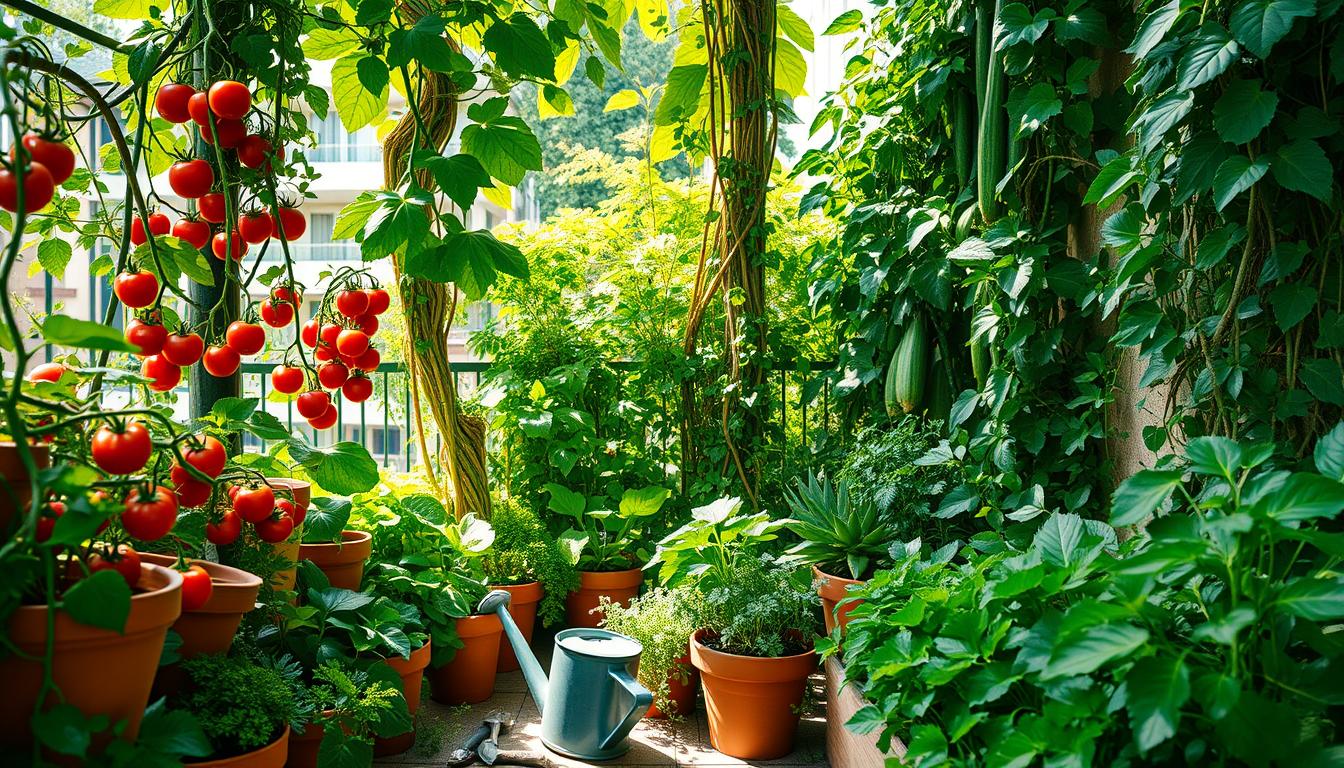Ever dreamed of growing your own fresh herbs and veggies but thought you needed a big yard? Think again! Even the smallest outdoor spaces can turn into mini-farms with a little know-how and creativity.
Urban gardening has become super popular as city folks enjoy growing their own food from their apartments. A well-planned balcony can produce a lot of food and create a green spot in the city.
Having a balcony garden is not just about fresh food. It also boosts your mood and helps the environment. Growing plants can reduce stress, and eating local food cuts down on emissions.
This guide is for everyone, whether you’re new to gardening or have some experience. You’ll learn how to make your balcony a productive garden all year round. From setting up your space to advanced tips, we’ve got you covered.
Ready to become an apartment farmer? Let’s start and see how you can turn your balcony into a productive garden!
The Urban Gardening Revolution
In cities, people are turning their balconies into gardens. This is more than a hobby. It’s a way to fight urban challenges and connect with our food. As cities grow and green spaces shrink, gardeners are using balconies to grow food.
Urban gardening has grown 30% in American cities since 2015. Balcony gardens are leading this growth in crowded areas. This shows a shift in how people view food and sustainability in cities.
Why Balcony Gardening Matters in Urban Settings
In cities, fresh produce can be hard to find or expensive. Balcony gardens offer a solution. They help address the lack of fresh vegetables in some neighborhoods.
Balcony gardens also add green spaces in cities. Studies show they can reduce stress and improve mental health. They act as natural air filters in polluted areas.
The Rise of Small-Space Food Production
Container gardening has improved a lot. Now, people can grow a lot of food in small spaces. They use vertical growing and other methods to get more from their gardens.
Small gardens are good for the environment. They cut down on emissions by reducing the need for transportation. A small garden can save up to 100 pounds of carbon dioxide a year.
These gardens also help cool cities. Plants cool the air and provide shade. They also catch rainwater, helping manage stormwater.
Community Impact
Balcony gardens have a big impact on communities. They inspire others to start gardens. They help people meet and build connections in cities.
These gardens also make neighborhoods look better and attract pollinators. They create mini-ecosystems in cities. Some communities even share knowledge and seeds through garden networks.
| Aspect | Traditional Garden | Balcony Garden | Urban Impact |
|---|---|---|---|
| Space Required | 100+ square feet | 10-50 square feet | Makes gardening accessible in dense housing |
| Water Usage | High (often wasteful) | Low (targeted irrigation) | Reduces urban water consumption |
| Yield Potential | Large harvests | Small, frequent harvests | Supplements grocery shopping |
| Community Visibility | Limited to backyard | Highly visible | Inspires neighbors to participate |
| Startup Cost | $300-500 | $100-200 | More accessible to various income levels |
Why Balcony Vegetable Gardens Are Worth Your Time
Balcony vegetable gardens offer many benefits. They are great for busy people and retirees alike. Growing your own food in a small space brings joy and rewards beyond just watching plants grow.
Fresh Produce at Your Fingertips
Imagine picking fresh basil for your pasta or a ripe tomato for your salad right from your balcony. No more last-minute grocery runs for missing ingredients.
Home-grown veggies are often more nutritious than store-bought ones. Commercial produce travels far and sits for days, losing nutrients. Your balcony produce goes from plant to plate quickly, keeping nutrients and flavor intact.
Mental Health and Wellbeing Advantages
Caring for plants is a natural stress reliever, perfect for city living. It brings moments of calm to our busy lives.
Gardening lowers cortisol, our stress hormone. Just 30 minutes of balcony gardening can boost your mood and give you a sense of pride as you see your plants grow.
Environmental Impact Reduction
Your balcony garden helps the environment. Growing some of your own food tackles several environmental issues.
Reduced Food Miles
Vegetables in American stores travel about 1,500 miles before you eat them. Your balcony produce travels just a few feet, saving on emissions. Even a small garden of lettuce saves fossil fuels and cuts carbon emissions.
Decreased Packaging Waste
Store-bought veggies come in plastic or containers that end up in landfills. Growing basics like tomatoes and lettuce at home cuts down on plastic waste. Your garden provides fresher food and helps reduce plastic pollution.
Assessing Your Balcony’s Potential
Turning your balcony into a garden starts with knowing your space. Before buying seeds or containers, figure out what your balcony can handle. This step saves time, money, and avoids disappointment in your gardening journey.
Understanding Sun Exposure and Microclimates
Sunlight is crucial for gardens. Watch how sunlight changes on your balcony during the day and seasons. Most veggies need 6 hours of direct sun, but some greens can do with less.
Your balcony might have special spots due to buildings, overhangs, or reflective surfaces. These areas can be warmer, cooler, windier, or more sheltered. Use this info to pick the right plants for each spot.
Weight Considerations and Structural Limitations
Safety is key in balcony gardening. Containers with wet soil and big plants can be very heavy. Make sure your lease or building rules allow for the weight.
Use light containers and soil mixes made for container gardens. Fiberglass, plastic, and fabric pots are good, lighter options than ceramic or concrete.
Privacy and Building Regulations
Know the rules before you start gardening. Many urban gardeners face surprises they didn’t see coming.
Common HOA and Apartment Rules
Building rules often cover looks, drainage, and changes to the structure. They might limit what you can see from the street, not let you attach things to railings, or have rules about water.
Creative Solutions for Restrictions
Find ways to work around rules. Choose containers that match your building’s colors, use removable trellises, and install drip trays to avoid water damage. Self-watering systems help keep plants watered without overflowing.
Essential Equipment for Successful Container Gardening
To start a balcony vegetable garden, you need the right tools and materials. Container gardening is different because it doesn’t use ground soil. With the right equipment, even a small balcony can grow fresh vegetables all year.
Container Selection and Materials
The containers you pick are key for your garden. Different materials work better in different climates and budgets. They affect how well your plants grow and how much weight your balcony can hold.
Plastic vs. Terracotta vs. Fabric
Each material has its own good points and downsides. Plastic is light and keeps water well, great for balconies that can’t hold much. Terracotta breathes well but dries out fast in hot weather. Fabric grow bags let roots breathe and prevent circling, but they need more water.
| Container Material | Pros | Cons | Best For | Durability |
|---|---|---|---|---|
| Plastic | Lightweight, affordable, retains moisture, available in many sizes | Can deteriorate in UV light, less breathable | Moisture-loving plants, weight-restricted balconies | 3-5 years |
| Terracotta | Excellent drainage, natural look, temperature regulation | Heavy, breakable, dries out quickly | Herbs, drought-tolerant plants, aesthetic gardens | 10+ years |
| Fabric | Promotes air pruning, prevents root circling, lightweight | Requires more frequent watering, less structural support | Root vegetables, plants sensitive to overwatering | 2-3 years |
| Self-Watering | Reduces watering frequency, consistent moisture | More expensive, heavier, potential for overwatering | Busy gardeners, consistent water-needing vegetables | 5+ years |
Size Requirements for Different Vegetables
The size of your containers affects plant health. Leafy greens like lettuce and spinach do well in 6-inch deep containers. Medium veggies like peppers and bush beans need 10-12 inches. Tomatoes and eggplants need 14-18 inches for healthy roots.
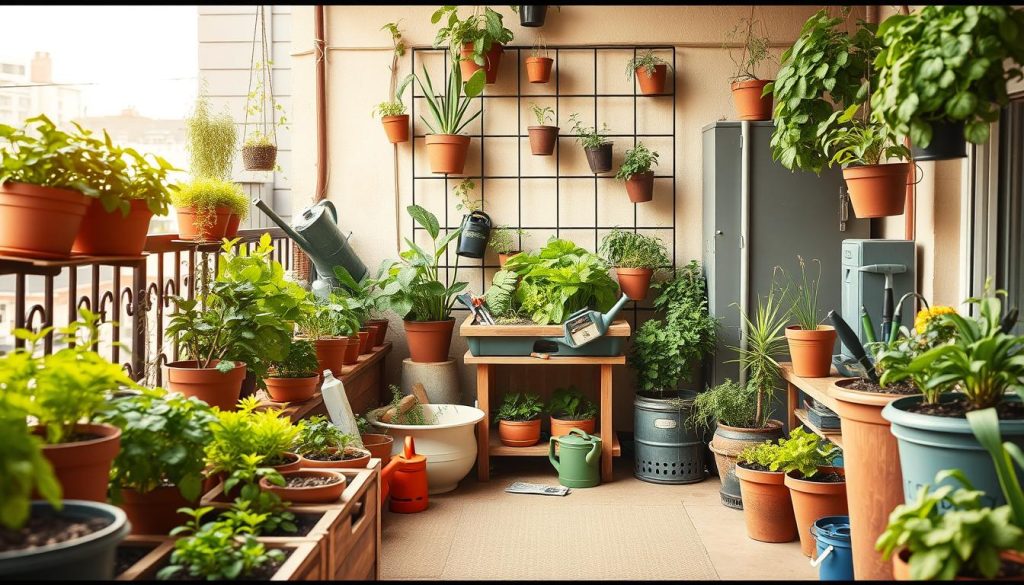
Soil Mixtures for Container Success
Regular garden soil is too heavy for containers. It can cause poor drainage and root rot. Use a light potting mix made for containers instead.
For a balcony garden, mix equal parts potting soil, compost, and perlite. This mix drains well, provides nutrients, and holds moisture. Add slow-release organic fertilizer at planting time for extra nutrition.
Watering Systems and Tools
Watering regularly is key for container gardens. A basic watering can works well for small spaces. For bigger gardens, a drip irrigation system with a timer is a good choice.
Self-watering containers have built-in water reservoirs. They save time and prevent drought stress. DIY systems using plastic bottles are also effective. A moisture meter helps avoid overwatering.
Space Optimization Techniques for Small Balconies
Even with a small balcony, you can grow a lot of plants. The trick is to use every inch of space. Think vertically and creatively to make the most of your balcony.
Vertical Gardening Solutions
Vertical gardening turns your balcony walls into growing spaces. Wall-mounted systems save floor space. They range from simple grids to complex pocket systems.
Trellises are great for climbing plants like cucumbers and tomatoes. They grow up, not out, saving space. Choose adjustable trellises to fit your balcony.
Stackable planters add multiple levels in one spot. They’re perfect for herbs and small veggies. This setup also improves air flow, reducing disease.
Hanging and Railing Planters
Hanging baskets use space you might not have. They’re great for herbs and small veggies. Look for ones with built-in water reservoirs to save time.
Railing planters attach to your balcony railings. They don’t take up floor space. Make sure your railing can hold the weight of the plants and water.
Multi-tiered Growing Systems
Multi-level systems increase your growing space. They stack plants vertically while keeping them well-lit. Simple stands or specialized towers can fit a lot of plants in a small area.
DIY Options on a Budget
Building your own vertical garden can be fun and cheap. Use wooden pallets or hanging shoe organizers. Add drainage holes and soil to make them planters.
Plastic gutters are great for growing lettuce and spinach. Cut plastic bottles in half for a budget-friendly planter for herbs and small veggies.
Commercial Systems Worth Investing In
Investing in commercial systems can be worth it. Modular planters and self-watering towers save space and time. They’re designed for easy use.
Hydroponic systems grow plants in nutrient solution. They grow faster and yield more, but cost more upfront. Consider durability and ease of assembly when choosing.
Best Vegetables for Balcony Gardens
Choosing the right vegetables for your balcony garden is key to a successful harvest. Not all veggies do well in pots. Luckily, many tasty and healthy options are perfect for balcony gardens. Even the smallest spaces can become a food source.
Leafy Greens and Herbs
Leafy greens are top picks for balcony gardens. They grow fast and can be harvested many times. Lettuce, arugula, spinach, and kale do well in shallow pots.
Herbs add flavor and are great for small spaces. Basil, cilantro, mint, and chives grow well in small pots. They also attract beneficial insects.
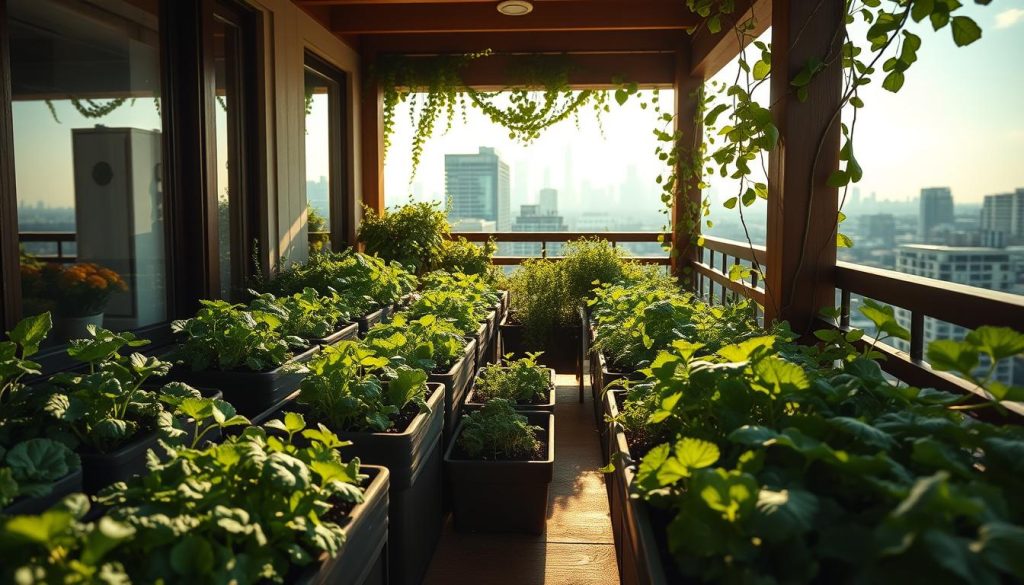
Microgreens are the ultimate space-savers. They’re young and packed with flavor and nutrients. A small tray can give you many harvests in just a few weeks.
Compact Fruiting Vegetables
Fruiting veggies need more space than leafy greens. But, there are compact varieties for containers. These plants give big harvests from small spaces.
Determinate Tomato Varieties
Determinate tomatoes grow to a set size and then produce all their fruit at once. They’re perfect for balconies. ‘Tiny Tim’ and ‘Patio Princess’ are great options. They need 5-gallon containers and support.
Dwarf Pepper Cultivars
Peppers are naturally compact and great for balconies. ‘Redskin’ and ‘Cajun Belle’ peppers grow on 18-inch plants. Ornamental peppers like ‘Black Pearl’ and ‘Bolivian Rainbow’ are colorful and edible. They thrive in 2-3 gallon containers with full sun.
Root Vegetables That Thrive in Containers
Many gardeners overlook root veggies for containers. But, some varieties do well in pots. Carrots, radishes, beets, and turnips are good choices.
Radishes mature in 21 days and need only 6 inches of soil. Beets and turnips need 8-10 inches but offer edible roots and greens. Even potatoes can grow on balconies in deep containers or potato grow bags.
| Vegetable Type | Container Depth Needed | Days to Harvest | Light Requirements | Recommended Varieties |
|---|---|---|---|---|
| Leafy Greens | 6-8 inches | 21-45 days | Partial to full sun | Buttercrunch Lettuce, Kale ‘Dwarf Blue Curled’ |
| Herbs | 4-6 inches | 30-60 days | Full sun | Compact Basil, Greek Oregano |
| Microgreens | 2-3 inches | 7-21 days | Partial sun | Sunflower, Pea Shoots, Radish |
| Tomatoes | 12-14 inches | 60-80 days | Full sun | Tiny Tim, Patio Princess, Tumbler |
| Root Vegetables | 8-12 inches | 30-60 days | Full sun | Paris Market Carrots, Cherry Belle Radish |
Seasonal Planning for Year-Round Harvests
To have a garden that grows all year, you need a good plan for each season. Balcony gardens face special challenges and chances with the seasons. With the right planning, your small space can keep giving fresh veggies all year.
Spring Planting Strategies
Spring is the start of your balcony garden’s year. Make a planting calendar for your zone and local weather. Cool crops like lettuce and peas do well in spring’s mild weather.
Use succession planting to keep your garden going. Plant different things every 2-3 weeks for a steady supply. Start seeds for warm crops like tomatoes indoors before the last frost.
Keep seedlings safe from late frosts with row covers or sheets. Container plants get too hot or cold easily, so move them inside if needed.
Summer Heat Management
Summer is tough for balcony gardens. Buildings can make it too hot for plants. Watch your plants closely, as they might need water twice a day in hot weather.
Use shade to protect your garden in summer. Put up shade cloth on sunny sides to block strong sun. Use tall plants to shade smaller ones.
Make a temporary shade with bamboo or canvas. For south-facing balconies, hang curtains to block heat but let air in.
Water Conservation Methods
Mulch is key in summer. Use straw or leaves to keep soil moist and cool. Self-watering containers save time and water.
Group plants by water needs for better watering. Use a drip system with a timer for steady watering. Collect rainwater for free, chemical-free water.
Fall and Winter Growing Possibilities
Don’t stop gardening in fall. It’s great for cool crops like kale and carrots. These veggies taste better after a light frost.
Use your building’s microclimate to grow longer. South-facing balconies stay warmer, adding weeks to your growing season.
For winter, grow cold-hardy crops like mustard greens. Use cloches or tunnels to protect plants from cold.
Winter is also for planning next year’s garden. Clean and store containers, and start composting. Think of your garden as a year-round project for more harvests.
Maintenance Routines for Thriving Plants
Urban gardeners can turn small balcony spaces into lush vegetable gardens. They need special care because balcony gardens face unique challenges. Regular care keeps your plants healthy and thriving.
Watering Schedules and Techniques
Container plants dry out quickly, so watering is key. Check the soil by sticking your finger in it. If it’s dry, it’s time to water.
Water in the morning so plants can soak it up before it gets hot. Different containers need different watering schedules. Terracotta dries out fast, while plastic holds moisture better.
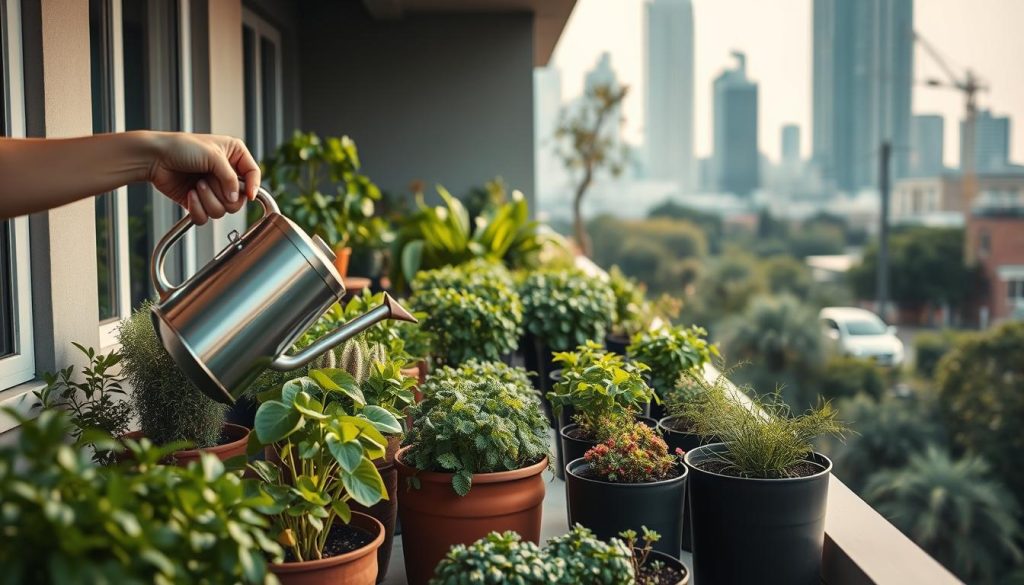
For when you’re away, use self-watering containers or wicking systems. Or, leave instructions for neighbors on how to care for your plants.
Fertilizing in Limited Soil Environments
Container plants use up nutrients fast, so they need more fertilizer. If leaves turn yellow or plants grow slow, they need more nutrients.
Organic Options
Compost tea is a great liquid fertilizer. Just steep compost in water for a day or two, then strain it. Worm castings add slow-release nutrients to your soil. Fish emulsion gives quick nitrogen but use it outside because of its smell.
Slow-Release Solutions
Granular slow-release fertilizers are perfect for balcony gardens. They give plants nutrients for weeks or months. Look for ones made for vegetables in containers. They’re great for busy gardeners because you don’t need to fertilize as often.
Pest Management in Urban Settings
Preventing pests is the best way to control them in balcony gardens. Check new plants before bringing them home. Also, regularly check your plants for pests.
Aphids, spider mites, and powdery mildew are common pests. Use eco-friendly solutions like neem oil spray or insecticidal soap. These won’t harm good bugs or bother your neighbors.
Planting certain plants together can help fight pests. Marigolds keep many pests away. Basil and mint repel flies and mosquitoes. These plants help create a balanced garden on your balcony.
Troubleshooting Common Balcony Garden Challenges
Balcony vegetable gardens are rewarding but come with unique challenges. Knowing how to tackle these can turn a struggling garden into a lush urban space. Let’s look at common problems and how to solve them.
Dealing with Limited Sunlight
Many balconies get too little sunlight due to shadows or direction. If you get less than 6-8 hours of direct sun, don’t worry. Place containers to catch as much light as possible. Use reflective surfaces like white walls or aluminum foil to bounce light back.
Light-colored containers also reflect sunlight. For very dark spots, grow lights can help during key growing times.
| Light Conditions | Hours of Sun | Suitable Vegetables | Special Considerations |
|---|---|---|---|
| Full Sun | 6+ hours | Tomatoes, Peppers, Eggplant | May need shade cloth in intense summer heat |
| Partial Sun | 4-6 hours | Beans, Cucumbers, Herbs | Position to receive morning sun when possible |
| Partial Shade | 2-4 hours | Lettuce, Kale, Asian Greens | Use reflective surfaces to increase light |
| Full Shade | Less than 2 hours | Mint, Spinach, Arugula | Consider supplemental grow lights |
Managing Wind Exposure
Balconies face stronger winds than ground gardens, harming plants and drying soil. Use trellises, fabric screens, or big containers to block wind.
For plants like tomatoes or peppers, use strong stakes or cages. Wind can also stop pollination. During flower times, hand-pollinate with a small brush.
Preventing Container Soil Issues
Drainage Problems
Poor drainage causes root rot and plant failure. Make sure containers have big holes for water to drain. Use pot feet or stones to help water flow.
If water stays on the soil or drains slowly, add perlite or coarse sand. For no-drainage containers, use rocks and landscape fabric.
Soil Compaction Solutions
Soil in containers gets compacted, hurting roots. Loosen the top soil monthly with a fork or chopstick. Be careful not to hurt roots.
Change the top third of the soil annually with fresh mix. For perennials, repot every two years with new soil to avoid nutrient loss and compaction.
Watching your plants daily is key for success. Look for signs of stress like wilting or pests. Fix problems quickly to save your harvest.
Harvesting and Using Your Homegrown Produce
After growing your balcony plants, learning how to harvest them right is key. It lets you enjoy the fruits of your labor. Growing your own food makes gardening more than just a hobby.
Maximizing Yields Through Proper Harvesting
Harvesting at the right time is crucial for balcony veggies. For leafy greens like lettuce and microgreens, cut the outer leaves. This way, you can get more from one plant.
Herbs like basil and cilantro grow bushier when you pick them regularly. Just pinch the stems above a leaf node. Picking in the morning gives you the best flavor.
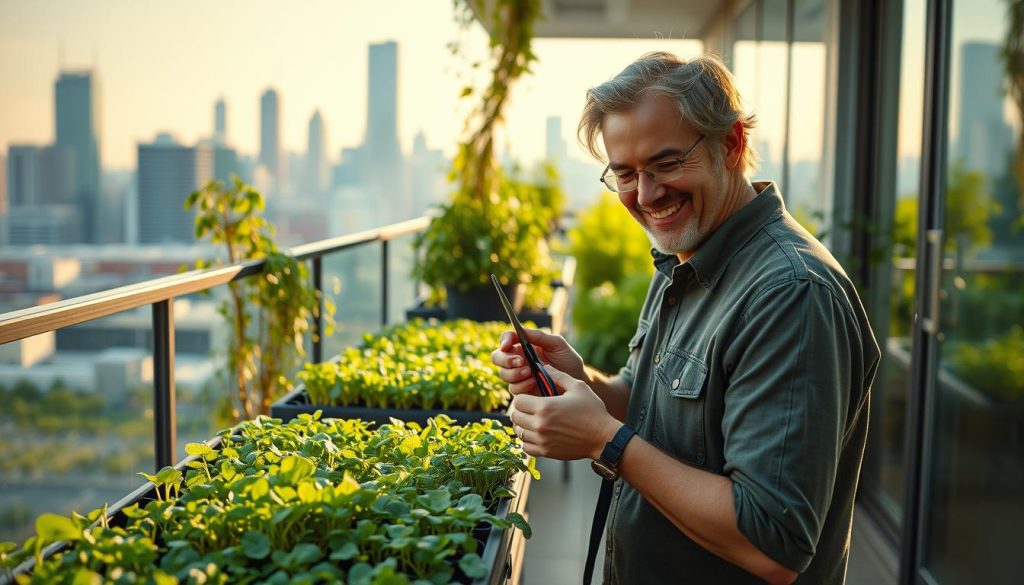
Fruiting veggies like cherry tomatoes and peppers grow more when you pick them often. Even a small garden can yield a lot if you harvest correctly.
Simple Preservation Methods for Small Harvests
Small gardens often give you small but regular harvests. Simple ways to preserve these can help you enjoy your harvest all year.
Freezing Small Batches
Use ice cube trays to freeze small harvests. Chop herbs finely and mix with oil or water before freezing. These cubes add flavor to many dishes.
Compound butters are another great way to keep herbs fresh. Mix chopped herbs into softened butter, shape into logs, and freeze. Slice off what you need whenever you want.
Herb Drying Techniques
For woody herbs like rosemary and thyme, hang them upside down. Tie small bundles with string and hang in a dry, well-ventilated area for 1-2 weeks.
For quick drying of tender herbs, try the microwave. Place herbs on paper towels and microwave in 30-second intervals until dry but still green.
| Preservation Method | Best For | Storage Time | Equipment Needed |
|---|---|---|---|
| Freezing in oil cubes | Basil, parsley, cilantro | 3-6 months | Ice cube trays, freezer bags |
| Air drying | Rosemary, thyme, oregano | 6-12 months | String, paper bags |
| Microwave drying | Mint, sage, dill | 6-9 months | Microwave, paper towels |
| Quick pickling | Cucumbers, radishes, peppers | 2-3 weeks refrigerated | Jars, vinegar, spices |
Cost Analysis: Is Balcony Gardening Worth It?
Growing your own food on a balcony is more than just fun. It’s about understanding the costs and benefits. You’ll invest in your garden and gain a lot in return.
Initial Investment Considerations
Starting a balcony garden costs money upfront. Basic containers can cost $5-$50, and good potting soil is $10-$20 per bag. Seeds are $2-$4, and seedlings are $3-$5 each. Tools like trowels and watering cans add $20-$40 to your budget.
To save money, get creative. Use old containers and buckets for planters. Share seeds with friends to save on costs. You can also use kitchen tools instead of gardening ones.
Long-term Savings and Returns
The money you save from growing your own food is significant. Herbs like basil can make $15-$25 in a season. Cherry tomatoes, lettuce, and greens also save you money, compared to store prices.
Most gardens break even in 1-2 seasons. The best crops for small spaces are herbs, greens, cherry tomatoes, and peppers. These grow well in containers and are expensive at the store.
Non-monetary Benefits and Value
Beyond saving money, balcony gardens offer many benefits. They teach biology, nutrition, and environmental science, great for families. Gardening also reduces stress and improves mental health.
Your home looks better and has cleaner air with plants. The biggest benefit is feeling connected to nature and growing your own food. This is priceless and often the most rewarding part of gardening.
My Personal Journey: From Balcony Novice to Vegetable Enthusiast
Five years ago, my balcony was just a place for a rusty bike and forgotten plants. My first try at gardening was a mess. I packed too many seedlings into small pots, and they barely survived.
I remember planting my first tomato seedlings with excitement. But then, they wilted from bad watering. I learned that gardening in the city takes patience.
Things changed when I started treating my balcony like a real garden. I set up a simple watering system and learned about spacing. I also picked vegetables that grow well in containers.
Now, my 50-square-foot balcony grows lettuce, cherry tomatoes, peppers, and herbs all year. It’s become my favorite spot for morning coffee.
There’s nothing better than serving friends a salad made just minutes before. My balcony garden has changed how I eat and see food. I’ve also met other gardeners in my building, sharing harvests and advice.
Going from a beginner to a confident gardener took time. Each season brings new challenges and lessons. If you’re starting your gardening journey, remember that every plant teaches you something.
Your balcony can be more than you think. Start small, keep learning, and watch your space turn into a garden.

